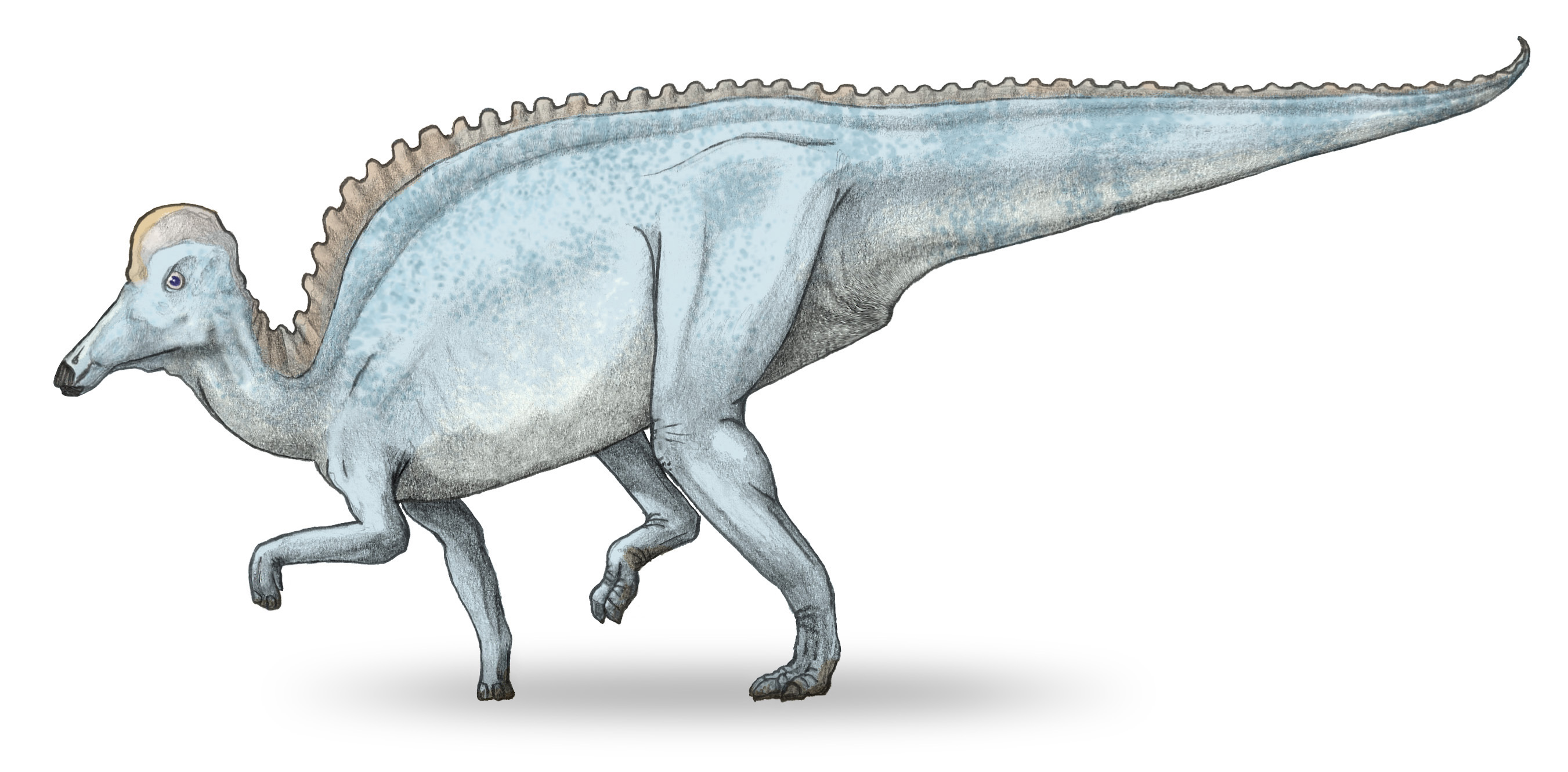- Amurosaurus
fossil_range =Late Cretaceous
regnum =Animal ia
phylum = Chordata
classis =Sauropsid a
superordo =Dinosaur ia
ordo =Ornithischia
subordo =Ornithopoda
familia =Hadrosauridae
subfamilia =Lambeosaurinae
genus = "Amurosaurus"
species = "A. riabinini"
binomial = "Amurosaurus riabinini"
binomial_authority = Bolotsky & Kurzanov, 1991"Amurosaurus" (IPAEng|əˌmʊəroʊˈsɔrəs; "Amur lizard") is a
genus of lambeosaurinehadrosaurid dinosaur found in theLate Cretaceous of easternAsia . Like most lambeosaurs, it would have been a primarilybiped alherbivore with a "duckbill" shaped snout and a hollow crest on top of its head, although such a crest has not been found.Fossil bones of adults are rare, but an adult would most likely have been at least 20 feet (6 m) long.Russia npaleontologist sYuri Bolotsky andSergei Kurzanov first described and named this dinosaur in 1991. The generic name is derived from theAmur River and the Greek word "sauros" ("lizard"). The Amur (calledHeilongjiang or "Black Dragon River" in Chinese) forms the border of Russia andChina , and is near where this dinosaur's remains were found. There is one knownspecies ("A. riabinini"), named in honor of the late Russian paleontologistAnatoly Riabinin , who conducted the first Russian expeditions to recover dinosaur remains in the Amur region in 1916 and 1917.All fossils of "Amurosaurus" have been recovered from a single bonebed locality, discovered in 1984 within the city limits of
Blagoveschensk in theAmur Oblast of far eastern Russia. This bonebed is found in theUdurchukan Formation , the oldestgeologic formation in theTsagayan Group of far eastern Russia and northeastern China. This formation is thought to belong to theMaastrichtian stage of the LateCretaceous Period , which ranged from 74 to 65 million years ago, although there is some disagreement as to when exactly within thisfaunal stage the Udurchukan was deposited. The sediments were laid down in thefloodplain of ariver , which transported the fossils, but only a short distance, judging by the randomly assorted, disarticulated, but well-preserved bones within the bonebed, including fragile skull elements. Only a small section of the bonebed has been uncovered, but 90% of the remains found so far belong to lambeosaurines like "Amurosaurus", mostly juveniles, with the rest belonging to other taxa, such as the hadrosaurine "Kerberosaurus ".Theropod teeth are also abundant, and there are many toothmarks on the bones, made bypredator s orscavenger s.The
holotype , or original specimen, consists of only amaxilla (upper jaw bone), and a dentary (lower jaw bone), both from the left side of the same individual. However, most of the other bones of theskull and skeleton have also been preserved in the bonebed, albeit of many different individuals. This other material was described more recently, making "Amurosaurus" the most abundant and completely known Russian dinosaur (Godefroit et al., 2004)."Amurosaurus" is characterized by many autapomorphies, or unique features, of the skull, as well as the
sigmoid al shape of theulna (a lower arm bone) when viewed from the front or side. Most other known lambeosaurines have hollow crests on the top of their skulls, and although the bones that would make up such a crest are unknown in this dinosaur, the bones of the roof of the skull are modified to support one, so it can be assumed that "Amurosaurus" was crested as well. As most of these features were described recently, as of early 2006, "Amurosaurus" has only been subjected to onecladistic analysis, which placed it as a basal member of the lambeosaurine subfamily of hadrosaurs, but more derived than either "Tsintaosaurus " or "Jaxartosaurus ".All known basal lambeosaurines come from Asia, which has led to the
hypothesis that lambeosaurines originated there and then later dispersed across theBering Strait toNorth America . Twoderived groups, the parasaurolophines ("Parasaurolophus ", "Charonosaurus ") and corythosaurs ("Corythosaurus ", "Nipponosaurus ")evolve d later. As members of both groups are found in North America and Asia, there must have been further dispersal after their evolution, although in which direction that dispersal occurred is still unclear (Suzuki et al., 2004; Godefroit et al., 2004).References
*Bolotsky, Y.L. & Kurzanov, S.K. 1991. [The hadrosaurs of the Amur Region.] In: ["Geology of the Pacific Ocean Border"] . Blagoveschensk: Amur KNII. 94-103. [In Russian]
*Godefroit, P., Bolotsky, Y.L., & Van Itterbeeck, J. 2004. The lambeosaurine dinosaur "Amurosaurus riabinini", from the Maastrichtian of Far Eastern Russia. "Acta Palaeontologica Polonica 49(4):" 585–618. [http://app.pan.pl/acta49/app49-585.pdf Available online as PDF]
*Suzuki, D., Weishampel, D.B., & Minoura, N. 2004. "Nipponosaurus sachalinensis" (Dinosauria, Ornithopoda): anatomy and systematic position within Hadrosauridae. "Journal of Vertebrate Paleontology". 24(1): 145–164.
Wikimedia Foundation. 2010.

